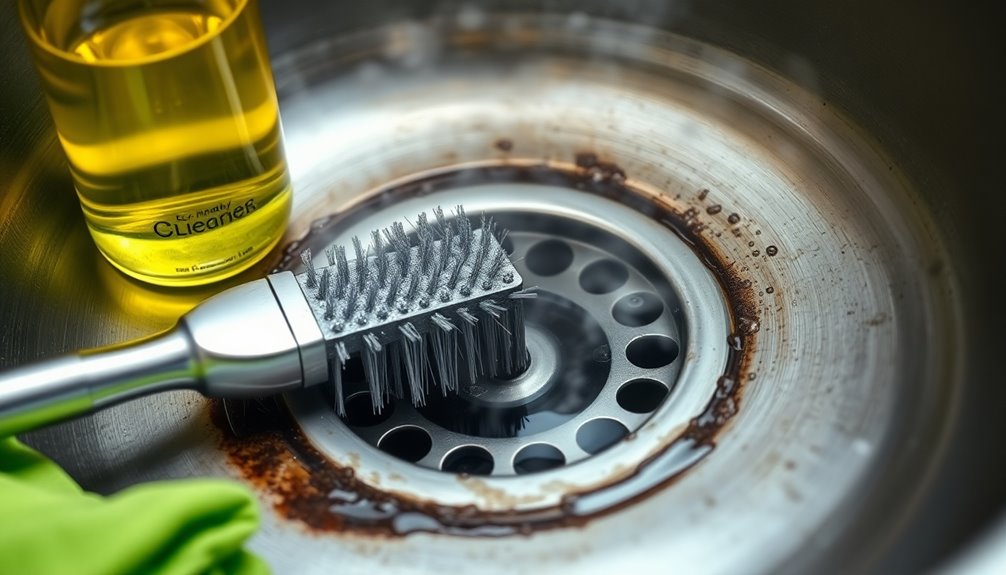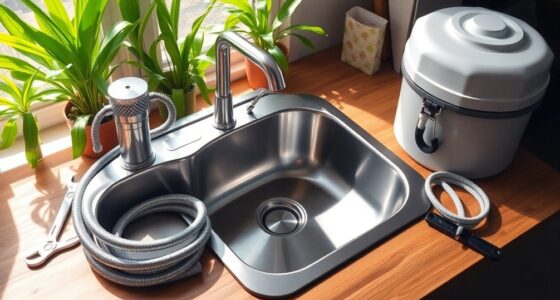To clean the black stuff in your sink drain, start by pouring half a cup of baking soda followed by vinegar down the drain. Let it sit for five minutes, then flush with boiling water. For tough buildup, use a full box of baking soda and a full bottle of vinegar. Regularly pour boiling water down the drain and consider using enzyme-based cleaners monthly to keep it clear. You'll discover even more tips to maintain your drains effectively.
Key Takeaways
- Pour half a cup of baking soda followed by half a bottle of vinegar down the drain to tackle black slime.
- For severe buildup, use an entire box of baking soda and a full bottle of vinegar, then flush with boiling water.
- Manually clean using a drain snake or disassemble the P trap for thorough access to pipes.
- Regularly pour boiling water down the drain and use enzyme-based cleaners monthly to prevent future buildup.
- Wear gloves and protective eyewear when using chemical drain cleaners for safety, and rinse thoroughly afterward.
Understanding the Causes of Black Stuff in Your Sink Drain
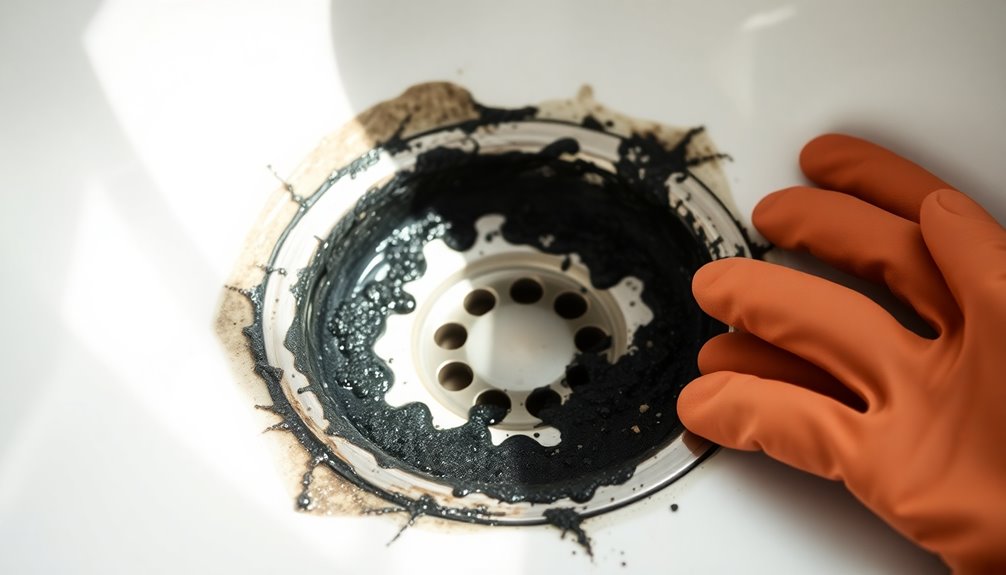
When you notice black stuff in your sink drain, it's often a sign of a bigger issue lurking beneath the surface.
This black slime, a biofilm, consists of organic materials like skin cells, hair, soap scum, and bacteria that accumulate over time. It tends to form in areas with infrequent water flow, creating a stagnant environment perfect for microbial growth.
Everyday activities, like washing hands or brushing teeth, contribute to the buildup of grease, dirt, and oils, transforming them into this unpleasant sludge.
While it might look like hair or debris, it's actually a mix of decomposing matter and bacteria.
Regular cleaning practices, such as pouring boiling water down the drain, can help prevent this accumulation and maintain a clean sink.
Effective Natural Cleaning Methods
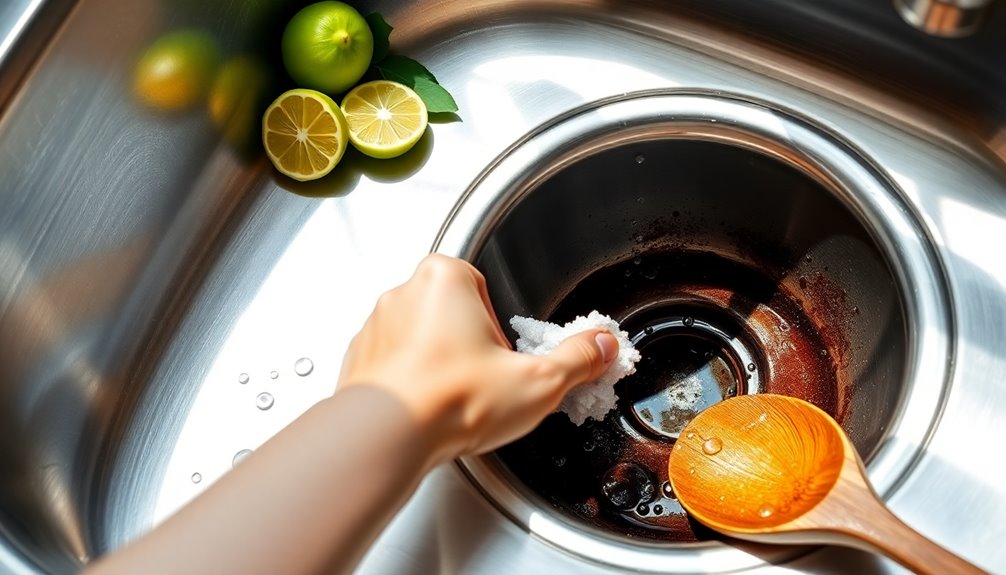
To effectively tackle the black slime forming in your sink drain, consider using natural cleaning methods that are both safe and efficient.
Start by pouring half a cup of baking soda down the drain, followed by half a bottle of vinegar. This fizzing reaction helps break down organic matter, including black gunk.
For severe accumulation, use an entire box of baking soda and a full bottle of vinegar, letting it react for five minutes before flushing with boiling water.
Regularly pouring boiling water down the drain can inhibit black slime growth. Additionally, monthly use of enzyme-based cleaners with natural ingredients promotes drain health by preventing future buildup. Incorporating anti-inflammatory herbs into your diet can further support your overall health, making your cleaning efforts more effective.
Finally, manually clean the drain and stopper with household detergent to remove any residual slime.
Utilizing Chemical Drain Cleaners Safely
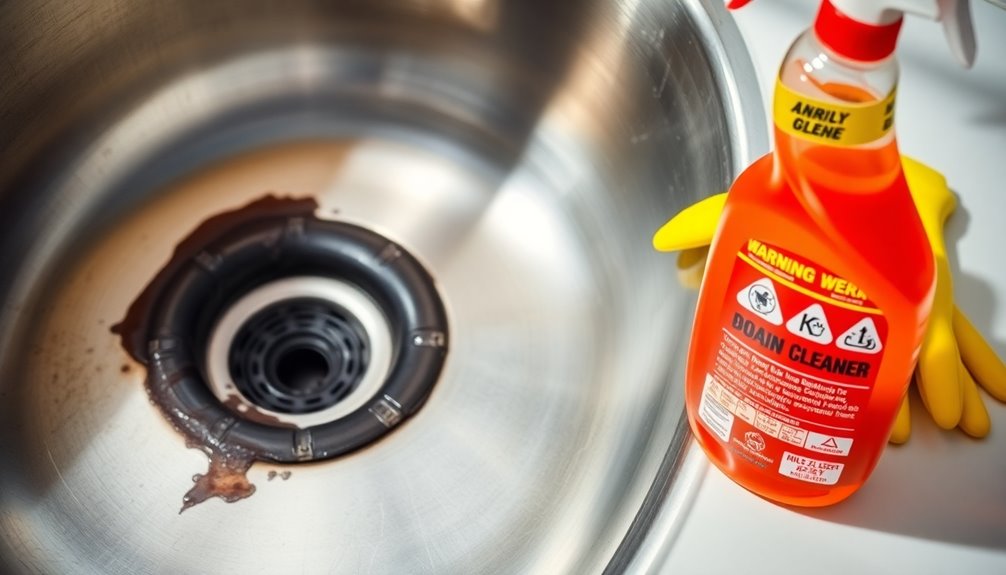
While chemical drain cleaners can be effective for stubborn clogs, it's vital to handle them with care to avoid potential hazards.
Always read the instructions on the label before using drain cleaners. When dealing with black stuff in your sink, wear gloves and protective eyewear to prevent skin contact or eye irritation.
After you remove the pop-up, slowly pour the cleaner down the drain and let it sit for about 30 minutes. This maximizes its effectiveness at breaking down clogs, including those caused by skin cells.
Once done, rinse the drain thoroughly with hot water for several minutes.
Tools and Techniques for Manual Cleaning

Cleaning your sink drain manually can be a straightforward process if you have the right tools and techniques at your disposal.
Start with a drain snake or a flexible cleaning tool like a Zip-It to dislodge hair and debris, making it easier to tackle the black sludge.
Next, disassemble the P trap under the sink for thorough access to the pipes.
Use a bottle brush to scrub the interior of the drain and overflow areas, effectively removing the gunk.
For stubborn residues, soak the drain with a mixture of bleach and dish soap, then flush with hot water.
Regular maintenance, including manual cleaning every few months, will help prevent the buildup of black slime and keep your drain flowing smoothly.
Preventative Measures for Long-term Maintenance
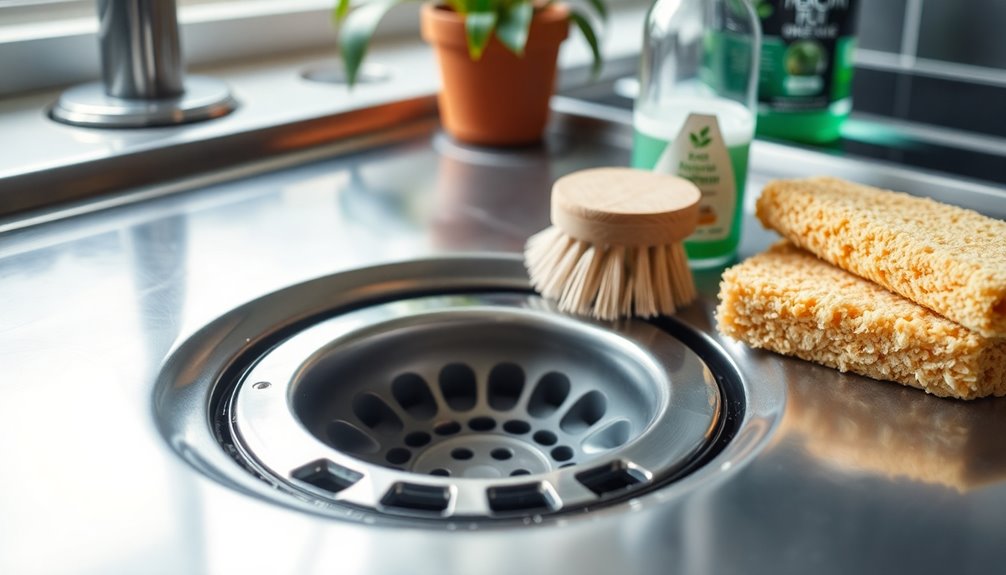
Regular maintenance is essential for keeping your sink drain clear and free from bothersome black slime.
Start by pouring boiling water down your drains at least once a month to dissolve and flush away accumulated organic materials.
Combine baking soda and vinegar monthly for a fizzing reaction that effectively breaks down grime and bacteria.
Avoid rinsing hair products and organic waste down your bathroom sinks, as this will greatly reduce black slime growth.
Consider using enzyme-based cleaners for monthly maintenance; they help break down organic materials without harsh chemicals.
Finally, verify proper moisture control in your bathroom to inhibit mold and bacteria growth, further preventing black slime formation.
Additionally, maintaining air quality in your home can also contribute to a healthier environment, reducing the likelihood of mold and bacteria in moist areas like sinks.
With these simple steps, you'll enjoy a cleaner, healthier sink drain.
Frequently Asked Questions
How Do You Get Rid of Black Gunk in Drains?
To get rid of black gunk in drains, start by pouring half a cup of baking soda followed by half a bottle of vinegar into the drain.
Let it fizz for 10-15 minutes, then flush with boiling water.
If the gunk persists, consider using a commercial drain cleaner according to the instructions.
Regularly pouring boiling water down your drain can help prevent buildup, keeping your pipes clear and functioning well.
How Do I Stop Black Mold in My Sink Drain?
Did you know that nearly 70% of homes have moisture issues that can lead to mold growth?
To stop black mold in your sink drain, keep the area clean and dry. Pour boiling water down the drain regularly to dissolve organic matter.
Use a baking soda and vinegar mixture monthly for a natural cleanse. Make sure your bathroom's well-ventilated to reduce humidity, and consider enzyme-based cleaners to prevent mold from returning.
Why Is There Black Gunk in My Sink Tap?
You might notice black gunk in your sink tap due to a buildup of organic materials, like soap scum and skin cells, mixed with bacteria.
This accumulation happens over time with regular use and can worsen if water stagnates.
Chemical reactions between your tap water and household products can also contribute.
If you're not flushing your tap regularly with hot water, mold and mildew can grow, leading to discoloration and unpleasant odors.
How Do You Clean Gunk Out of a Kitchen Sink Drain?
When your kitchen sink drain is feeling a bit under the weather, it's time to give it a rejuvenating cleanse.
Start by pouring boiling water down the drain to melt away stubborn residues. Then, treat it with a delightful concoction of baking soda and vinegar, letting it fizz for about 10-15 minutes.
Rinse with more boiling water, and for tougher clogs, a drain snake can work wonders.
Regular upkeep will keep your drain happy!
Conclusion
To sum up, tackling that troublesome black stuff in your sink drain doesn't have to be intimidating. With the right remedies and regular routines, you can guarantee a sparkling, sanitary space. Remember to combine natural methods with manual maintenance to keep your drain delightful and debris-free. By prioritizing preventative practices, you'll promote prolonged plumbing performance. So, stay savvy and secure your sink's sparkle for a satisfying, stress-free experience every time you wash up!
